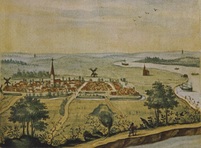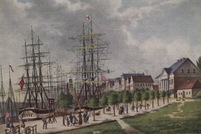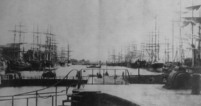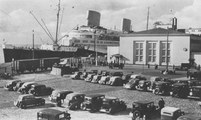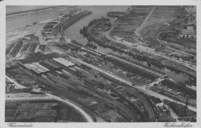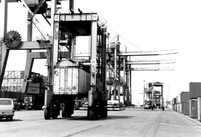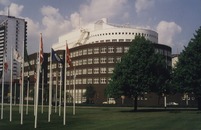City History of Bremerhaven
A short walk through history
Bremerhaven is a young city with an ancient history. In the northeastern district of the seaside city, the Wurtendorf Weddewarden, was settled by humans some 2,000 years ago, and in the year 1091 a first documentary can be found. The slightly younger written record of the villages Geestendorf and Wulsdorf, which in the present belong to the city, dates back to the year 1139. The settlements which were situated on moraine islands rising from large swamps and riverine were located on the road from Altenwalde to Bremen. Only the market town Lehe, which was mentioned in documents in 1275 for the first time, gained some local significance as official residence and market town with lesser urban rights.
The story of Lehe is closely linked to the fact that the Geeste, the first navigable tributary of the Weser, in its mouth region fulfills a protective port function for oceangoing vessels. And that a trading center was created at the junction of the army path over the Geeste near the Leher ferry. This situation favored plans to create a fortified trading city in the Geeste estuary. The fortress Carlsburg, built by the Swedes in 1672, did not prevail, the mercantilist project of an ideal city disappeared from the scene after a few years.
Politically, this area at the mouth Geeste was contested for a long time by the Archdiocese of Bremen and the City of Bremen, where Lehe sought repeatedly to preserve its rights through protection contracts with the Bremen Council. 1648/54, the area the together with the entire Archdiocese of Bremen came under Swedish sovereignty. In 1719 it finally, after short-term Danish occupation, was taken over by the Electorate, later Kingdom, of Hanover.
After the Napoleonic Wars a new development started, which quickly led to a dual city and port founding on the Geeste estuary. A Hanoverian refuge erected 1819-1821 became the starting point of a much more important project. The Free Hanseatic City of Bremen, in order to escape the increasing deterioration of its port by silting of the river Weser, on the initiative of Mayor Johann Smidt, founded in 1827 on the site of the former Carlsburg a new outer harbor: Bremerhaven.
In conjunction with the trade with America and the 1832 onset of mass emigration, Bremerhaven experienced a rapid boom. Next to the port was a growing, urban influenced settlement, which was granted city rights in 1851.
On the southern Geeste shore, just across the river, the Kingdom of Hanover founded in extension of the emergency port in direct competition with Bremerhaven 1845/47 the harbor Geestemünde, which was expanded in the years 1856-1863. Following the the English model Geestemünde received modern dock and port facilities, with direct rail connections. As a result, Geestemünde became an industrial location and the hub for timber, rice and kerosene.
During this development the Geeste estuary became the starting point of significant economic activity as well as geographic expansion and increasing population density. The Bremensian Bremerhaven became a passenger ship port won due to the emigration and the growth of transatlantic passenger transport. The port became world famous especially in conjunction with the North German Lloyd which established the “Lloyd Halle" and the "Columbusbahnhof", as well as by the fast steamers "Bremen "and the "United States" which came to the port regularly.
On both banks of the Geeste many shipyards emerged with Helge facilities and dry docks and, especially in Geestemünde, a plethora of machine shops and other suppliers were established. Deep-sea fishing became the third big economic driver alongside trade and shipbuilding since the mid-1880s. In 1896 in Geestemünde a separate fishing harbor was built with its own infrastructure. This was expanded significantly in 1925.
The economic activities, combined with strong population growth, required a constant expansion of the commercial space and the urban settlement area by itself. While the ports of Bremen in Bremerhaven shifted farther and farther to the north, the ports of Hanover, which became Prussian in 1866, in Geestemünde expanded in the opposite direction. Correspondingly, the municipalities changed their residential, commercial and recreational areas. The new port cities and the older settlements gradually grew toward each other. This was true for Bremerhaven and Lehe, where a new residential area sprang up at their border, as well as for Geestemünde and Geestendorf, where the latter became a working-class suburb of the port cities. So was soon formed a coherent metropolitan area of settlement, which at the eve of the First World War housed about 100,000 people.
The political development could not keep pace. Geestemünde and Geestendorf were united in 1889 under the name of the port city, but the same could not be realized for Bremerhaven and Lehe, because of the country's borders. For this reason the political reorganization of the twenties only led to the merging of the Prussian Geestemünde, that had already incorporated Wulsdorf in 1920, and Lehe into the new city Wesermünde which in 1927 integrated further border communities. Not until 1939, when the reorganization of the empire took place, was the port of Bremerhaven integrated into Wesermünde, although the international port area remained under Bremen authority. The Second World War left after the allied bombing of 18 September 1944 the inner city largely destroyed. After the war, Wesermünde as the appointed American supply harbor for Germany, together with Bremen formed the American enclave within the British occupation zone. It was in 1947 renamed into Bremerhaven and was part of the new federal state of Bremen. Since then the seaside town enjoyed large autonomy within the two-city state.
Economically, great changes have since taken place. After the reconstruction of the 1950s and 1960s, the city center was given a new face and the successful integration of a large number of refugees and displaced, the traditional sectors port handling, shipbuilding and fishing again experienced a strong upswing.
In the 1960s began a structural change, which initially covered the port sector, then the other sectors of the economy and is still not complete. The rapid decline of the transatlantic passenger traffic, Caused by the use of planes, was compensated by container handling. Then in the mid-1980s with the closure of the renowned traditional exacerbated Rickmers shipyard the shipbuilding crisis has become visible. Today there are only two shipyards of medium size in Bremerhaven.
Likewise, the decline of the German deep-sea fishing had significant effects on the former largest fishing port on the continent, which could however be offset in part by increased diversification. Traditional fish processing has experienced an extension to general food processing. This development was intensified through the development of food technology at the University of Bremerhaven.
Currently, the major city on the lower Weser with its 113,000 inhabitants is increasingly developing scientific research capacities, promoting new technologies, especially in the area of climate change and the expansion of tourism services.
As part of this development, close application-oriented links between the research and educational institutions (Alfred Wegener Institute for Polar and Marine Research, Bremerhaven University), various facilities, technology transfer and related companies, marine biological applications, offshore wind energy technology and the food technology are established.
While for this sector the fishing port offers extensible areas, the tourism is predominantly situated at the Alten and Neuen Hafen (old and new port) near the city center. The classic institutions like the German Maritime Museum, the Historical Museum Bemerhaven / Morgenstern Museum and the zoo at the sea are increasingly supplemented by new attractions such as the German Emigration Center, the Mediterraneo Shopping Centre and a modern suburban marina and in the summer of 2009 the Climate House. So Bremerhaven now presents itself as a city in transition and with clearly identifiable future prospects.
For more detailed information on the history of Bremerhaven the city archive is available.
Stadtarchiv Bremerhaven,
P.O. box 21 03 60,
27524 Bremerhaven;
Stadtarchiv@magistrat.bremerhaven.de
Text: Dr. Hartmut Bickelmann, City Archive
Photos: City Archive

